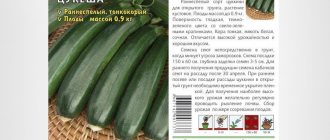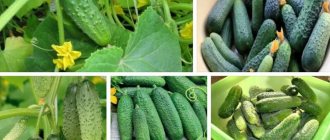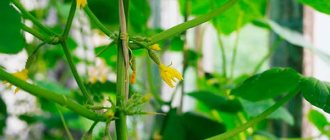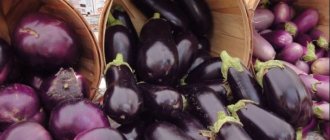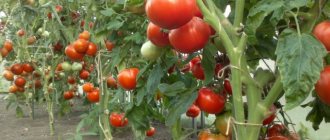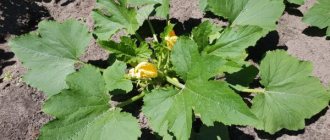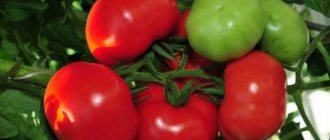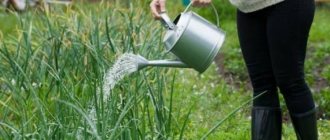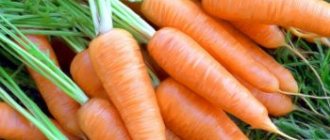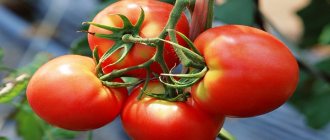Cucumbers are one of the most popular crops among gardeners in our country. Already in the second half of spring, you can try fresh fruits grown on your own, and the winter menu is not complete without pickled vegetables, so summer residents try to grow them in large quantities.
Not only owners of large plots can please themselves with a rich cucumber harvest. Using bush varieties, fruits can be collected even in small beds. What are the advantages of bush cucumbers and what are the nuances of caring for them, we will tell you further.
General description of bush cucumbers
Bush cucumbers are distinguished by their low growth of the main stem - 50 cm, while in classic varieties the main loops reach 3 m . Moreover, they have a minimum number of side branches. Thanks to this, these varieties are compact bushes.
Bush cucumbers have short internodes . Because of this, the plants appear heavily leafy. They produce a large number of fruits, the size of which reaches 10 cm, but they are usually removed from the bush when they reach 5 cm. They are convenient to preserve and look beautiful on the table.
All bush cucumbers are characterized by rapid and rapid ripening . Already 3 weeks after the appearance of the first shoots, the harvest is harvested. The growing season of bush cucumbers is also short. Already a month after the formation of the first fruits, the bushes are dug up and new plants are planted in their place.
The taste of cucumbers is rich and sweet . They are crispy, have a tender skin and lots of bumps.
All bush varieties are resistant to most viral and fungal diseases . Thanks to the rapid setting of fruits, gardeners have time to harvest before the outbreak of the most common diseases.
This is interesting. Bush cucumbers are decorative and look interesting even in outdoor flowerpots.
A little about Kustovoy
The variety is quite old and proven. An application for registration in the State Register of Breeding Achievements was submitted by the authors back in 1975, and after testing at breeding experimental stations, the variety was included in the State Register in 1980 and recommended for commercial production in our country. Familiar to many experienced gardeners. Some have been growing it for decades.
Bush greens grow in clusters
The variety is non-hybrid, you can collect your own seeds, so some gardeners have been growing Kustovaya for decades, passing on excess seeds to friends and neighbors, because many do not even know or remember what this variety is called. Meanwhile, unlike many hundreds of varieties, often very similar to each other, the Kustovaya variety is easy to distinguish by its external characteristics from the usual cucumbers and by its long vines. Although it is very problematic to distinguish them from their fellow bush varieties, such as Malyshok, Malysh, Korotyshka, only by the size of the already developed bush. These three brothers do not produce vines longer than 50 cm, that is, they are completely compact, and therefore less productive. The Kustovoy variety in this row has the tallest bush, and therefore produces a larger harvest.
Recommended for cultivation in all regions of our country where, due to climate conditions, it is possible to grow cucumbers. And even due to the short period of ripening and fruiting, it is better suited than many other varieties for growing in cold regions.
The greens (fruits) of this variety are no different from many classic varieties with a long vine, either in appearance or taste. The variety is early ripening, under normal conditions it produces the first fruits within 45–50 days after germination. The length of the greens is 8–12 cm, weight up to 100 g. Although, of course, no one forbids collecting greens in the size of gherkins, 7–8 cm, or growing cucumbers until the seeds are fully ripened in a brown testicle measuring up to 25 cm and weighing about 300 grams.
They are no more bitter than other varieties due to unfavorable conditions. The fruit is thin-skinned, making it very suitable for salads. It goes into pickling, but with restrictions, like many other early varieties. It goes well in pickling with a short shelf life, for example, as “lightly salted” cucumbers. They can also be salted in open containers according to numerous “barrel” recipes, but if stored for too long, the cucumbers become soft. And it is not recommended to preserve it under sealed lids in jars - the lids often swell.
Cucumbers grow in “quintuplets”, with several ovaries side by side on one shoot.
The main difference between the varieties is the shape of the lashes. More like a zucchini, it grows as a bush, with several shoots immediately from the root. Does not produce long lashes exceeding 60–70 cm.
The bush is noticeably different from other varieties
Varieties of bush cucumbers
We present the most popular varieties of bush cucumbers :
- Mikrosha . Variety for open ground. The height of the bush reaches 40 cm. The fruits are egg-shaped and reach a length of 5 cm. The peel is dark green and dense. The seeds are small. The taste is sweetish. Has high immunity to viral and fungal diseases.
- Gift . Recommended for open ground. The bush reaches a height of 50 cm. It is resistant to viral and fungal diseases. Dark green fruits with thin skin grow up to 10 cm in length.
- Shorty . A bee-pollinated variety that is suitable for growing in open ground. The bush is medium spreading. The maximum height of the main stem reaches 45 cm. Zelentsy are light green, with white stripes and delicate, thin skin. The length of the fruit does not exceed 9 cm. It has high immunity to olive spot and powdery mildew.
- Bush . The height of the bush does not exceed 50 cm. The fruits are cylindrical, up to 8 cm long, green in color, with thin skin. They are distinguished by their ease.
The advantage of bush cucumber varieties is that collected seeds from independently grown fruits are suitable for planting . Planting material is collected from large, yellowed fruits on the bush.
Growing
The agricultural technology for growing bush cucumbers is practically no different from the technology for growing long-stemmed plants. The difference lies in the need for more frequent watering and dense planting in the beds.
Bush cucumbers are planted with pre-grown seedlings at home or by sowing seeds in open ground.
Growing bush cucumbers with seedlings
This method allows you to get the harvest earlier.
Growing seedlings is quite simple. To sow seeds, you can use universal soil or soil from a garden plot, after mixing it with humus. Sowing seeds is carried out in wooden boxes or small cups. When planting seeds purchased in a store, no preliminary preparation for planting is required. Seeds collected on the site require preparation. Before planting, they must be placed in a cool place for some time and kept in a solution of potassium permanganate. These measures will help harden the seed and increase its resistance to diseases.
Shoots appear five to six days after sowing the seeds in the ground. Young plants should be provided with timely watering. Boxes with seedlings are placed in a warm room. After four true leaves appear, the seedlings are planted in a garden bed if the soil has warmed up to 20 degrees or in a temporary greenhouse, which will help protect the plants from lower temperatures.
After planting seedlings, weeding and weeds should be systematically removed. This will help increase yield and protect plants from diseases.
Planting bush cucumbers in open ground
The selection of bush cucumber seeds for open ground is carried out taking into account climatic conditions.
Plants require warmth, regular moderate soil moisture and diffuse lighting. Plants do not tolerate excess moisture in the soil and direct sunlight. Bush cucumbers can be grown in any soil. High yields are obtained from plants grown on light, nutritious soils that are well-permeable to moisture and air. Planting cucumbers in the same beds can be done once every five years, so you should take care of applying organic and mineral fertilizers in advance.
Seeds of bush cucumbers for planting in open ground require preliminary preparation. Since the plant stems are tender, it is necessary to harden them and prevent diseases.
Before planting, the seeds are soaked for 30 minutes in a pale pink solution of potassium permanganate and washed thoroughly in running water.
10-14 days before sowing the seeds, it is necessary to prepare the beds. To do this, fertilizers are added to the soil. Compost, manure or mineral compounds can be spread over the bed and leveled with a rake.
Sowing of seeds is carried out in holes or grooves treated with growth stimulants. Seeds are planted in the garden at a distance of 7-10 centimeters from each other, the distance between the rows should be at least 45 centimeters. If the soils are heavy, they are mulched with peat. When sowing seeds into a hole, it is necessary to cover the crops with plastic wrap. This will provide protection from the cold and help the seedlings grow strong and hardened.
We must not forget about cutting the film over the hole in a timely manner, since the seedlings may get sunburn if they come into contact with it. In this case, it is safer to use non-woven covering material. When growing bush cucumbers in this way, the fruit will ripen earlier.
Hybrids of bush cucumbers
Hybrids of bush cucumbers are often more resistant to diseases than varieties . Therefore, many gardeners prefer them:
- Sturdy baby F1 . The height of the bush varies between 30-40 cm. The fruits are egg-shaped, weighing 60-80 g. Resistant to viral and fungal diseases.
- Baby F1 . The height of the central stem reaches 30 cm. The fruits are elongated, dark green, with large tubercles. They reach a length of 9 cm. The hybrid is resistant to viruses and powdery mildew.
- Hector F1. The height of the bush reaches 40 cm. The light green fruits grow up to 8 cm in length, have a thin peel and light pubescence. The hybrid is resistant to cold weather.
- Aladdin F1 . The maximum height of the bush is 70 cm. The cucumbers are elongated, dark green in color, with sparse tubercles. Each fruit reaches 10 cm in length. The hybrid is demanding on soil composition and watering. Is immune to downy mildew.
- Boy with thumb F1. The height of the bush varies between 30-40 cm. The length of the dark green prickly fruits does not exceed 8 cm. It is immune to viral and fungal diseases.
Seeds from hybrid fruits are not used for planting . Often, they grow into plants that have parental rather than hybrid characteristics.
Characteristics
Productivity
The horse variety has good yield. The length of the fruit is from 7 to 9, rarely - 10 cm. According to this characteristic, cucumbers of the Connie variety are classified as greens. The surface of the greens has a uniform green color of medium saturation. Small tubercles with small spines are present on 90% of the surface of the fruit. Some gardeners perceive the presence of thorns as a disadvantage.
Bloom
Starts early. The variety is self-pollinating and does not depend on the presence of bees, which helps the gardener in those areas where there are no or very few bees for one reason or another.
bloom
The variety is early ripening, so it takes 30-45 days to ripen. You can reduce the ripening time by planting ready-made seedlings instead of seeds and using fertilizers.
Of course, it is necessary to plant the seeds at the right time - in the spring. If planted later or earlier, the variety may produce a poor harvest, germinate late or too early, or even not germinate at all.
Plant parameters
The variety is a first-generation hybrid and also parthenocarpic. That is why it will not produce seeds. And in general, growing the same hybrid variety the next season from collected seeds does not lead to the desired result. The fact is that a hybrid is a specially arranged vegetable. All its properties have been selected to achieve optimal results. If you continue to plant it from seeds, these properties will be lost.
It should be remembered that the combination of traits of hybrid varieties is unstable and gives results only in the f1 generation.
Frost resistance
The variety has good frost resistance.
Heat resistance
The variety has average heat resistance; in extreme heat it requires additional care: watering and protection from excess sunlight. Heat-loving.
Planting cucumbers
Planting bush self-pollinating varieties of cucumbers for open ground is not much different from planting ordinary ones. Due to the compact size of the plants, they are planted close to each other .
Cucumbers are demanding on the composition of the soil. They begin preparing the beds for planting cucumbers in the fall. To do this, the soil is dug up and cleared of plant debris. For every 1 m², add 15 g of urea, 30 g of superphosphate and 6 kg of humus. The ingredients are mixed with soil.
In the spring the soil is dug up. For every 1 m², add a glass of ash to reduce acidity and saturate the soil with useful microelements. 2 days before planting cucumbers, water the soil with a hot solution of copper sulfate (1 tbsp. L of copper sulfate per bucket of water).
The choice of place for planting cucumbers also matters . Semi-shaded areas where groundwater is not too close to the surface are suitable for this crop.
It is important to observe crop rotation . No other melon crops should grow in the selected area during the previous two years.
Bush cucumbers are grown by seedlings and without seedlings . In both cases, before using the planting material, it is prepared:
- Warming up . A month before planting, the package with seeds is placed near the battery.
- Calibration _ The seeds are sorted, leaving dense large specimens without damage, dark spots, or voids.
- Disinfection . The seeds are soaked for half an hour in a light pink solution of potassium permanganate or for 6 hours in a solution of Fitosporin.
- Growth stimulation . Seeds are soaked for 6-12 hours in a growth stimulator. The products “Epin” and “Solution” are often used.
- Hardening . The seeds are placed in the refrigerator for a day.
After processing, the planting material is ready for planting.
Note! Often purchased planting material is processed in the factory. Information about this is indicated on the packaging.
Seedless method
Cucumbers are grown without seedlings in the southern regions . They are sown in the ground when the soil at a depth of 15 cm warms up to +12°C. This usually happens in early May.
Seeds are sown in rows to a depth of 4 cm . The distance between plants should be 20-25 cm, between rows - 40 cm. Some gardeners sow two seeds in one hole, and if both germinate, then pinch out the weaker plant.
After sowing the seeds, the beds are watered with warm water . Next, the soil is moistened as it dries. The crops are covered with a film, which is opened slightly during the hottest part of the day and ventilated for two hours. After the first shoots appear, the beds are covered with film only at night. When the threat of night frosts has passed, it is completely removed.
For greenhouses, the principle of sowing seeds is the same . In this case, the cultivation of cucumbers begins in the second half of April. The crops are not covered with film.
Seedling method
The seedling method is considered the most reliable . It is suitable for growing cucumbers in all regions and allows you to get a harvest much earlier.
The timing of sowing seeds for seedlings depends on the region:
- southern - early April;
- central – second half of April;
- northern - early May.
Cucumbers do not tolerate picking well, so the seeds are sown immediately in separate containers - plastic and peat cups are suitable. Before use, they are disinfected with a dark pink solution of potassium permanganate.
For cucumber seedlings, buy a universal soil mixture or prepare the soil yourself. To do this, mix two parts of garden soil and humus with one part of sawdust or sand. The earth is disinfected with a dark pink solution of potassium permanganate or calcined in the oven.
One seed is sown in each container, buried 2 cm. The crops are watered with warm water, covered with film and put in a place with a temperature of +24...+26°C.
When the seeds germinate, the film is removed. Plants are grown at room temperature . If there is not enough natural light, then use phytolamps.
How to care for seedlings:
- The seedlings are watered 2 times a week with water at room temperature. For watering use a spray bottle.
- After the appearance of two true leaves, fertilizing is applied . It is prepared from 1 liter of water and 1 teaspoon of “Nitrophoska”.
- Two weeks after sowing the seeds, the seedlings are taken outside . Hardening begins at one hour, gradually increasing the time to 12 hours.
Seedlings are planted 3 weeks after sowing the seeds . By this time, the soil temperature at a depth of 15 cm should reach +12°C.
Holes are dug in the ground using a 25x40 pattern. Seedlings are placed in them along with a lump of earth, without deepening the root collar.
After planting, the plants are watered. The next watering is possible no earlier than in a week.
For the first two weeks, cucumbers are covered with film at night . This reduces the threat of plant death due to night frosts.
Growing
This variety can be grown twice per season.
Bush varieties of cucumbers are not very picky to care for, but they need timely watering and fertilizing. Due to its early ripening, the variety can be planted 2 times per season. The first time in April, and the second time in July.
Seed preparation
To get healthy plantings, you need to choose the right seed material. Large seed producers such as Aelita carefully analyze their products for the presence of pathogens. By buying seeds in bulk, a summer resident risks introducing mold spores into the ground.
Varieties of bush cucumbers are widely represented on the market. In addition to the classic one, you can choose other analogues of culture. Showed themselves well:
- Chelyabinsk undersized;
- Shorty;
- Baby;
- Baby F1.
Before planting, the seeds are soaked in a warm solution of potassium permanganate for additional disinfection for 15-20 minutes. You cannot leave them in the liquid for longer, otherwise the cotyledons may rot.
Landing
Since bushes are grown in open ground, plants can be planted in two ways. The first is planting seedlings in mid-April. To do this, 2-3 seeds are placed in separate containers with a nutrient substrate. The first shoots appear 5-7 days after planting. The earthen ball should always be kept moist, and after watering, carefully loosen the soil without touching the tender roots of the seedling. In May, the seedlings are transplanted to a permanent place.
Agricultural technology when planting seeds directly into the ground is slightly different. This is done a little later, in mid-May, when the danger of return frosts has passed. The optimal planting pattern is 30 cm between plants and at least 50 cm between rows.
The beds must be prepared in advance. In order for the crop to grow well and bear fruit, during autumn digging, rotted horse, cow or bird droppings are added to the soil. In spring, wood ash is poured into the holes.
Watering
Bush cucumbers, like their tall relatives, need constant moisture. It is recommended to water them either early in the morning or in the afternoon. In hot weather, fumes rising from wet soil can injure fruits and leaves.
The bush should not be watered with cold water. If watering is done from a well, it is recommended to install special containers. The sun's rays will heat the water in them during the day, and in the evening it can be poured into the beds. Violation of this simple rule leads to the development of root rot and death of the plant.
Water is poured strictly at the root. It is undesirable for it to get on the leaves and shoots of the plant. Afterwards the ground is carefully loosened.
Rules for caring for bush cucumbers
It is believed that bush cucumbers are easier to grow than climbing cucumbers . Caring for this type of culture has its own nuances.
Caring for bush cucumbers:
- Watering. Bush cucumbers will have to be watered more often than climbing ones. In hot and dry summers - up to twice a day. The soil is moistened in the morning and in the evening (when the sun is inactive) with water at room temperature.
- Garter. Bush cucumbers do not need additional support. Some gardeners, when a large number of fruits form, attach the central stem to a wooden peg.
- Loosening . After each watering, the soil is loosened to restore air exchange. You cannot loosen the beds too deeply. This is due to the fact that the root system of cucumbers is located close to the surface.
- Mulching . It is recommended to cover the beds with a layer of straw, hay or sawdust. This will slow down the growth of weeds, reduce the likelihood of plant infection, protect the plantings from insects, and slow down the process of moisture evaporation.
- Weeding . Be sure to ensure that many weeds do not appear in the cucumber beds. They slow down the growth of cultivated plants and increase the likelihood of their infection.
- Feeding. Bush cucumbers are especially demanding when it comes to feeding. They are added every two weeks. Alternate mineral and organic compositions.
Many gardeners wonder whether and how to grow cucumbers in open ground. Such varieties are determinant, so there is no need to limit their growth point . They do not form lashes and branch weakly. There is no need to pick and shape the bush.
Experienced gardeners recommend pinching a few lower leaves to improve air exchange . This procedure is optional.
Diseases and pests
Most bush cucumbers are immune to fungal and viral diseases. Some varieties can still be infected.
The most common diseases of cucumbers include:
- powdery mildew - a white or reddish coating appears on the leaves, which leads to withering of the plants;
- downy mildew - dry yellow spots appear on the leaves. The ground part of the bush withers, ovaries do not form;
- olive spot - characterized by olive or brown spots on the ground part of the bush;
- verdigris - brown (not dry) spots appear on the greenery of the plant. Weeping areas form on the fruits;
- white rot - the entire plant, along with the fruits, becomes covered with a white, damp coating, which leads to rotting of the bush;
- gray rot - the ground part of the bush becomes covered with weeping brown spots, on which a gray coating forms;
- root rot - manifests itself in the form of destruction of roots and wilting of plants.
The diseases described are caused by fungi and bacteria . To prevent their development, plantings are sprayed with “Fitosporin” or copper sulfate every two weeks. If the disease has already affected the plants, then use special means - for example, “Fitosporin” (once every 2 days) or “Previkur” (once every 14 days). In this case, the affected leaves are removed.
Viral diseases have no cure and are difficult to prevent . Most bush varieties are immune to them.
To protect against aphids and spider mites, cucumber bushes are sprayed with a soap solution (1 piece of soap per 10 liters of water) or a decoction of bitter herbs. If folk remedies do not help, then use the drug “Barrier”.
Advantages and disadvantages
The Bush variety has many more advantages than disadvantages. These can be listed:
- Endurance. The variety is undemanding to soil and tolerates heat, drought, and strong winds more easily than others. It can be planted in remote areas when it is not possible to care for the plant constantly. Although, of course, with more careful care, the yield will be higher.
- Easy care. The plant does not need to be pinched, tied to trellises or formed into a bush. The shoots do not intertwine with each other and therefore they are well illuminated by the sun and ventilated. As a result, the likelihood of developing diseases is reduced. The plant does not require any special feeding, other than those recommended for all cucumbers without exception.
- Early harvest, smooth ripening of fruits. The plant manages to produce its harvest before mid-summer, when some plants begin to develop all sorts of diseases due to heat and humidity. Thus, the risk of losses is reduced.
- Drought resistance. The plant does not need frequent and abundant watering, since its medium-sized wattles evaporate and require much less liquid than other varieties. In dry and hot weather, it is enough to keep the soil under the bush slightly moist.
The main disadvantage of this variety is the inability to grow it in greenhouse conditions. The fact is that Kustova needs bee pollination, and it is difficult to open access for pollinating insects to it while maintaining the microclimate. In addition, Kustovoy is not capable of producing the same rich harvest as modern tall hybrids intended for cultivation in closed conditions.
Cucumbers with a long vine can grow a new vine, on which an ovary will subsequently form, that is, an additional harvest. The bush tree forms the first spring ovaries on its short vine, on which fruiting will end. Therefore, this variety should not be grown by farmers who want to make money by selling vegetables. It is simply not profitable to occupy greenhouse space with them.
Attention!
The bush variety can be planted 2 times per season: first in April, and then in July.
Reviews
Marina, Ekaterinburg
– I tried growing bush cucumbers last year. We were interested in the unusual characteristics. At the end of May, I planted 4 bushes with seeds under the film, designing them as a decorative plot. When the bushes are hung with cucumbers, the view is stunning. I was pleased with the result - I love small crispy cucumbers. The family used them fresh, and I also made lightly salted ones. Lightly salted ones generally turn out great! Now I want to allocate a plot of land and plant more bushes. Maybe I’ll try the blanks too.
Evgenia, Pskov
-I grow bush cucumbers for summer consumption. I plant where there is space, but, of course, sunny. If there is room for one bush, I plant one bush; if there is more space, I plant 2-3 bushes. For now, I use humus and compost as fertilizers, because our soil is fertile, everything grows well. In the future I will try mineral supplements. I really like the compact bush - it’s easy to care for and water. Yes, since there is no separate place, I plant seedlings. Convenient for such landings. The harvest is not particularly abundant, but if you like the variety, then why not plant it just to enjoy eating.
